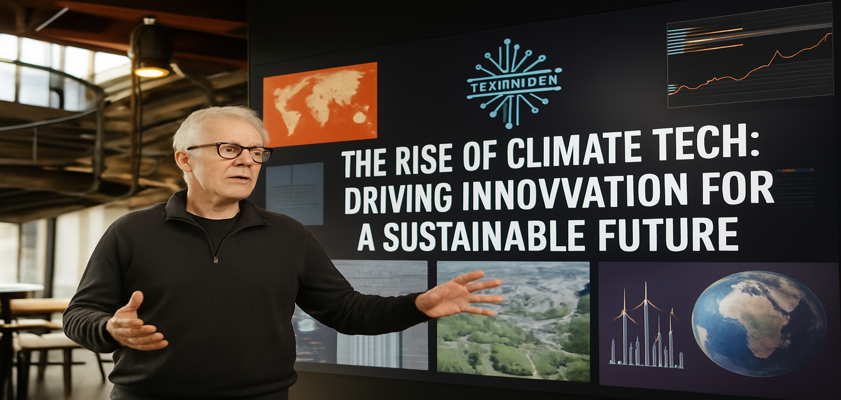Climate change has become the major problem of the 21st century, causing changes in policies, economies, and society in different countries. With global temperatures increasing and extreme weather becoming more extreme than ever there has been no greater time to act. Scientists believe that to prevent the worst outcomes, at least by causing dramatic and perilous climate change, there must be a reduction in the GHG emissions in the world. Dramatically reduce (near to half by 2030 and zero by 2050) emissions. Reaching this target will not just need policies and commitments, it will need the quick development and implementation of ground-breaking means.That is why climate tech or climate technology comes into the spotlight.
Climate tech refers to a range of technological innovations, which are specifically created to minimize output of emissions, capture carbon dioxide chemicals in the atmosphere and enable societies to adjust to a warming climate. It integrates innovations in renewable energy, agriculture, transport, carbon sequestration and IT systems to optimize a top down change. In addition to environmental impacts, climate tech also offers an exceptionally prospective business market, as well as investment and entrepreneur opportunities.
This paper discusses the definition of climate tech, its pillars, sectors, market forces, obstacles, and opportunities as well as the reasons why it is the hub of net zero ambitions globally.
What Is Climate Tech?
Essentially, climate tech is a special branch of technology that directly offsets climate change. Whereas cleantech is concerned with all aspects of sustainability, climate tech is limited to efforts to reduce GHG emissions, make adaptation possible, and improve our knowledge of the climate system.
There are three categories:
Mitigation
These are technologies that have an aim of reducing the emission or avoiding it such as the use of renewable energy systems, the use of electric cars and the energy efficient infrastructure.
Adaptation
Zuhalf obtained measures that enable communities to endure climatic factors such as flooding, drought- resistant crops, as well as, resilient supply chains.
Enablement
The technologies that will facilitate clearer data, financing and accountability on climate action, i.e., carbon accounting platforms and ESG reporting tools.
The Importance of Climate Tech
The need to take action on climate is enhanced by the frightening figures. The IPCC calculates that the net zero will require close to 40 percent reductions in emissions that rely on technologies not yet at scale. The International Energy Agency (IEA) suggests that the investment in clean energy should increase by four times to reach the mark of 4 trillion dollars a year by 2030 so as to keep pace with 1.5-degree global warming. Climate tech is at the nexus of the challenge and the opportunity. It not only makes available ways to reduce emissions but also unleashes economic opportunities, such as creation of jobs, durable infrastructure, and cost savings to firms.
Another example is that firms turning to efficient energy solutions or the circular economy have found that sustainability results in cost reductions in addition to eco-footprints.
The most important areas of Climate Tech
Energy and Power
The largest contributor to all emissions is energy comprising close to three-quarters of the global totals including all uses. Innovations in this area of climate tech include:
Renewable energy
Geoexchange, air, celestial, and hydroelectric power.
Power storage
novel batteries and huge storage systems.
Smart grids
Smart grids are electronic systems that can enable an effective system in securing a perfect balance between demand and supply.
Green hydrogen
Hydrogen is a clean energy that is manufactured with the use of renewable power.
This, coupled by the other inventions is changing how energy is provided, delivered and consumed.
Transportation
Transportation is one of the largest contributors at over 16 percent; therefore, it is a major climate technology arena. Stimulating insight is:
- Charging networks and electric vehicles.
- Fuel Cells.
- Sustainable fuels and sustainable aviation aircraft designs.
- Maritime innovation like electric shipping and low-carbon fuels.
- Companies such as Tesla have helped to spearhead the climate tech movement by showing how it is possible to bring those changes to the mainstream alongside massive interest among investors.
Agriculture and food systems
Land use and agriculture are close to 18 percent emissions. Climate tech innovations seek to make the food system more sustainable by:
- Substitute foods, like cultured meat and insect dopers.
- Precision agriculture: placing the IoT/AI to use in water and fertilizing.
- Another option would be regenerative agriculture that would also make the soil healthy and sequester carbon.
- Vertical agriculture, less use of land and water.
- Companies such as Beyond Meat also demonstrate how consumer preferences can be used to propel demand in the field of sustainable food technology.
Constructions and Infrastructures
The world consumes building energy up to about 30 percent. Climate technology is envisioning building and functioning differently with:
- Low energy cooling systems and heat pumps.
- Smart management systems of building
- Use of low carbon building materials, e.g. green cement and recycled steel.
- Retrofitting solutions, retrofitting old infrastructure so as to make them energy efficient.
Carbon Capture and Removal
Carbon capture, utilization, and storage (CCUS) is one of the most promising and at the same time challenging spheres.
Technologies include
- Point-source capture that directly captures CO 2 directly in industrial emissions.
- Direct Air Capture (DAC) that takes the carbon out of the air.
- Bioenergy with Carbon Capture and storage (BECCS).
- Interventions that are nature-based like reforestation and soil carbon sequestration.
- In Europe alone there are more than 30 companies that work on CO 2 removal technologies. Elon Musk is pushing harder in the world of carbon capture with his $100 million prize on any innovation in this area.
The investment landscape
Not only is climate tech an environmental necessity, but it is also an economic opportunity as well. PwC says the sector is now one of the most rapidly growing areas of venture capital with its State of Climate Tech report.
- In 2021, the technology climate received more than 56 billion in VC investments through 1.6k deals which is a record year.
- Despite the declining rate of investment in 2022, owing to the adverse macro-economic conditions, the rate picked up again in the subsequent years in 2023 and 2024, with momentum supported by the powerful policy frameworks.
- The climate tech sector in Europe has grown in value by two times its figure since 2020.
- As of 2021, 78 climate technology unicorns (startups with valuation above 1 billion) were tracked worldwide.
- Governments are also playing an important part. The U.S. Inflation Reduction Act paired 370 billion dollars in climate and clean energy spending, and the European Union Green Deal seeks to rally more than 1 trillion euros. Such policy signals are opening up new possibilities of massive innovation and scaling.
Challenges Climate Tech is Facing
Although it holds great promise, climate tech is dogged by a number of challenges:
Capital intensity
Solution also has high upfront capital intensity especially in energy and carbon capture.
Scaling walls
The transition between the pilot projects and the commercial deployment is slow and can be characterized as the wall of death.
Policy uncertainty
The inconsistent regulations and slowest turning processes slow down the advancement.
Technological maturity
Some of the frontier solutions, such as DAC and green hydrogen, are not mature yet.
Global equity
The fact that the developing nations should be able to afford and use climate technologies is a priority issue.
Opportunity and the future
The reverse side of such challenges is opportunity. Climate tech is riding winds of fortune:
Policy support
Regulatory and historic government funding.
Corporate pledges
There are thousands of companies that have each committed to net zero by 2050.
Mobilization of workforce
More professionals are switching to transition with their jobs to climate tech.
Cross-sector innovation
Coordination between the various fields of energy, AI, finance and agriculture is boosting innovation.
We could see climate tech go mainstream in the next decade. Such areas as grid modernization, carbon removal, alternative proteins, and climate AI will become the next areas of growth.
Conclusion
Climate tech is not simply an overhaul of technological capabilities, but a complete change in thought process about energy, industry and the future of the planet. As climate tech is focused on mitigation, adaptation, and enablement, it presents a scrupulous yet realistic road map towards net zero. However, the industry cannot be reduced to the emission decrease benefit alone. It fuels innovation, economic sustainability and social influence. Going against green energy systems, laboratory meat and direct air capture, smart cities, among other climate technology solutions, show that the human race is able to innovate in times of crisis. Because as investors, entrepreneurs, governments and citizens line up behind this movement, one thing is obvious; the future life of the planet lies in the success of climate technology. Climate technology is not only an opportunity as a business, but an umbilical cord to a sustainable and resilient world.
FAQ’s
Q1. Put simply, what is climate tech?
The term that refers to those technologies and innovations which can assist them in eliminating greenhouse gases, capturing carbon in the air and permitting humans to address the impacts of climate change is called climate tech.
Q2. What does climate tech have in new versus cleantech?
Cleantech refers to any kind of environmentally-friendly technology, whereas climate tech defines technologies that actively address the problem of climate change by firstly reducing emissions, secondly removing carbon, and lastly, adapting to our changing climate.
Q3. What are the most active sectors in the use of climate tech?
The main spans are in energy, transportation, agriculture, food systems, building, infrastructure and carbon capture.
Q4. What is the significance of climate tech?
It assists the world in cutting emissions, developing resilience against catastrophic weather, creating new green opportunities and in approaching a net zero by 2050.
Q5. What are the greatest threats to climate tech?
Expensive initial investments, long policy processes, and challenges of increasing technologies to scale are some of the key problems.
Q6. What is the role of climate tech in our everyday life?
It will generate cleaner energy, electric mobility, sustainable food, smarter homes and buildings and new ways of ensuring that communities are safeguarded against floods, droughts and severe weather.







